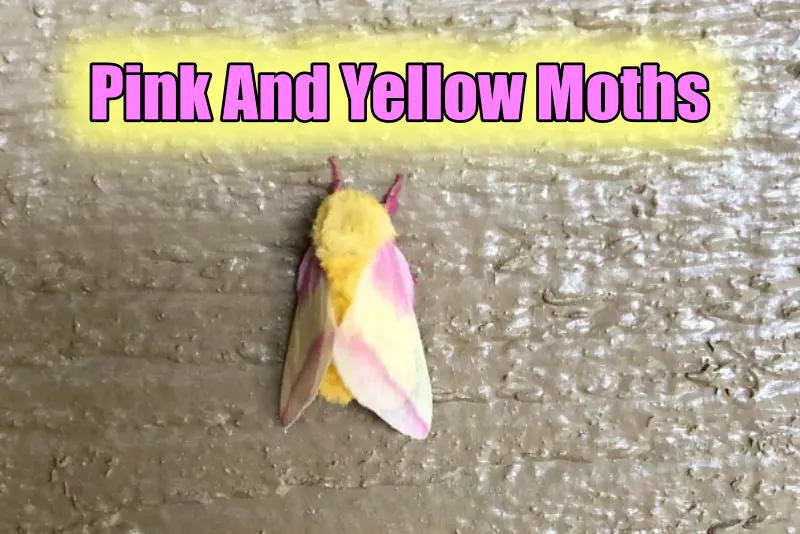In childhood, we all liked to catch butterflies and moths. As we grow, we come across many beautiful creatures. and we all see moths and butterflies flying around us in parks, gardens, and many other places. There are different colors we found in the moths. But do you ever see a pink and yellow moth? If not, then here are several species of pink and yellow moths.
Let’s begin
10 Pink and Yellow Moths
1. Rosy Maple Moth
Scientific name: Dryocampa rubicunda
Dryocampa rubicunda, also known as the rosy maple moth, is a small North American moth. Johan Christian Fabricius was the first to describe it in 1793. Further, it is known for its wooly body and pink and yellow coloration. Moreover, males have bushier antennae, allowing them to sense female pheromones for mating. Furthermore, the species prefers maple trees, with adult females laying yellow ovular eggs in groups of 10 to 40 on the underside of maple leaves.
Do you know the rosy maple moth is the smallest of the silk moths? You can find that male moths have a wingspan of 3.2 to 4.4 cm, and female moths have a wingspan of 3.8 to 5 cm. Do you know the species is famous because of its unique pink and yellow coloration, reddish-to-pink legs, and antennae? Also, you can identify these pink and yellow moths on the basis of their yellow bodies, hindwings, and pink forewings with a triangular yellow band.
2. Choristostigma Roseopennalis
Scientific name: Choristostigma roseopennalis
Next on our list of pink and yellow moths is Choristtostigma roseopennalis, which was described by George Duryea Hulst in 1886. You can find these moths on the landscape of Mexico and the United States. Do you know the moth has a wingspan of 18 mm? Also, it has canary yellow forewings, bright rosy costa, and white hindwings. Adults are on wing from May to September.
3. Elephant Hawkmoth
Scientific name: Deilephila elpenor
Deilephila elpenor, also known as the elephant hawk moth or large elephant hawk moth, is primarily found in central Europe and the Palearctic region. Do you know the moth has distinctive olive and pink coloring, making it one of the most recognizable moths in its range?
Moreover, it is often confused with the small elephant-hawk moth, a closely related species.
Furthermore, they have sensitive eyes that allow them to see color even in low light. You can see that this species of moth has nocturnal color vision.
Other than that, the D. elpenor moth has olive-brown forewings outlined with pink, two pink lines running through the wings, and a black inner half that gradually turns pink from the middle outwards. The head, thorax, and body are also olive-brown, with pink markings throughout.
4. Small Elephant Hawkmoth
Scientific name: Deilephila porcellus
Deilephila porcellus, the small elephant hawk-moth, is a moth in the Sphingidae family, first described by Carl Linnaeus in 1758. It has a wingspan of 45–51 millimeters and flies from May to July.
Further, the moth’s forewings are ochreous with an olive tinge, while the hindwings are blackish and pinkish. Also, the moth’s head, thorax, and body are pinkish, with a patch of white hairs above the base.
Furthermore, the moth’s coloration is highly variable, with pink coloration absent in drier and warmer areas of Asia Minor and Central Asia. The larva is grayish brown or darker gray, merging into yellowish brown on the front rings.
The caterpillar is pale grayish green with blackish bristles in the early instars, and the head and undersurface are yellowish. The larvae feed on Galium and Epilobium.
5. Mint-Loving Pyrausta Moth
Scientific name: Pyrausta acrionalis
Pyrausta acrionalis, also known as the mint-loving pyrausta moth, is a moth found in eastern North America, including Alabama, Georgia, Massachusetts, Mississippi, New Hampshire, New York, Ontario, Tennessee, West Virginia, and Wisconsin.
Do you know that the moth has a wingspan of 14–18 mm? Also, you might be amazed to know that adults have deep rose-violet forewings with yellow borders. The larvae feed on Mentha species, including peppermint and wild mint.
You can find the adults mostly in pink, purple, or brown, with a middle band of mottled yellow patches crossing their forewings.
The triangular shape of their wings and cheerful colors make them easy to spot in their varied habitats, especially at night near lights in mint-growing areas.
6. Rosy-Striped Knot-Horn
Scientific name: Oncocera semirubella
Oncocera semirubella is a small moth in the Pyralidae family with a 26–30 mm wingspan. It flies in one generation and is easily disturbed on short grassland. Found in European regions and East Asia, it feeds on bird’s-foot trefoil, white clover, Ononis species, horseshoe vetch, and Medicago species. It is attracted to light and sugar.
7. Common Crimson-and-Gold Moth
Scientific name: Pyrausta sanguinalis
Pyrausta sanguinalis is a rare crimson and gold moth found in western Europe, as far east as southern Finland. Further, the moth has a 14–18 mm wingspan. Other than that, you can find this moth in various locations, including north-west England and Scotland. The forewings are brownish-ochre with purple crimson markings.
Moreover, the hindwings of males are light gray, females are grey, and the terminus is crimson in the middle. The larvae are greenish-grey and reddish-tinged and feed on common sage, rosemary, and thyme. The moth flies from June to August, depending on its location.
8. Southern Purple Mint Moth
Scientific name: Pyrausta laticlavia
Pyrausta laticlavia is also known as the southern purple mint moth, found in New Jersey, Florida, Texas, Oklahoma, and California. Further, it can also be found in San Francisco Bay and the Sacramento Valley. With a wingspan of 17 mm, it flies from June to August. Larvae are reared on Rosmarinus officinalis.
9. Western Sheep Moth
Scientific name: Hemileuca eglanterina
The sheep moth, also known as the common sheep moth, is a silk moth native to western North America. It is a dayfly and feeds on Ceanothus, Rhamnus, and Rosa plants. Moreover, the species was first described by Jean-Baptiste Boisduval in 1852.
Further, it has a 5.5–8.5-centimeter wingspan and a slender body. Also, the forewings are pink with a yellow streak, while the hindwings are yellowish with variable black markings.
An all-black form is found near Mount Shasta. The larvae are black with branched yellowish spines that become orange in later development and an orange-brown head.
10. Clover Hayworm Moth
Scientific name: Hypsopygia costalis
Hypsopygia costalis, also known as the gold triangle or clover hay moth, is a moth species in the Pyralidae family found in Europe. Its wingspan is 16–23 mm, and adult moths fly from May to July.
They are harmful to clover hay and other hay mixed with clover. To prevent depredations, keep the hay dry and well-ventilated. The caterpillar breeds in moist or matted material, making it unfit for feeding. Treatment involves burning the webbed material and thoroughly cleaning the affected area.
Conclusion:
So, we conclude it here: these are some of the pink and yellow moths. Next time, if you see any of these, show off your knowledge among your friends. If you want to know more about the animal kingdom, connect with HowItSee.
Reference:
https://en.m.wikipedia.org/wiki/Dryocampa_rubicunda
Also Read:

As a content writer, I like to write about different niches. I have a curiosity about nature and animals. And like to learn about them. Through my writing, I like to share my experience and knowledge with you. I hope you are enjoying it too.

